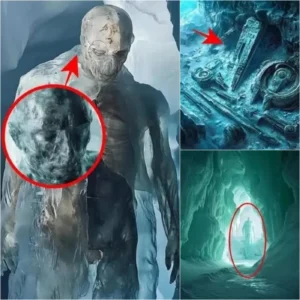For centuries, myths and legends about giants have captivated human imagination. From the ancient stories of Goliath in the Bible to the Norse mythologies of towering beings, giants have often been relegated to the realm of fiction. However, recent archaeological discoveries may challenge that notion. In a shocking turn of events, evidence is emerging that suggests giants might not just be figments of ancient storytelling but real historical figures who once roamed the Earth.

The Discovery: Uncovering the Evidence
The intrigue began when a group of archaeologists, digging in a remote region of Eurasia, stumbled upon massive skeletal remains buried deep in the ground. These bones, measuring far larger than those of an average human, raised immediate questions. Could these be the remains of an ancient race of giants? The skeletons, some measuring over 12 feet in length, were astonishingly well-preserved, giving experts plenty to analyze.
Radiocarbon dating suggests these bones are over 5,000 years old, placing them squarely in the ancient human timeline. Alongside the skeletal remains were tools and weapons—enormous compared to standard human artifacts—implying that these creatures not only existed but thrived in a society with advanced capabilities.
Mythology Meets Reality: Giants in Ancient Texts
The concept of giants has permeated various cultures across the globe. In the Bible, the Nephilim are described as a race of giants, the offspring of the “sons of God” and “daughters of men.” Similarly, Greek mythology speaks of the Gigantes, formidable creatures locked in battle with the gods of Olympus. Even in Native American folklore, legends of giant beings who once inhabited the land abound.
These myths were often dismissed as exaggerated tales meant to explain the mysteries of the ancient world. But with the new archaeological evidence, many are beginning to wonder: were these stories based on real events?
Dr. Jonathan Reyes, a leading anthropologist, has been studying the skeletal remains. “The size and structure of these bones are unlike anything we’ve seen in modern humans,” he explained. “While it’s easy to attribute myths to overactive imaginations, this discovery forces us to reconsider the possibility that giants may have played a real part in human history.”
The Scientific Debate: Were Giants Human?
Not everyone is convinced. While the skeletal remains have sparked widespread excitement, the scientific community remains divided. Some argue that the bones belong to a previously undiscovered species of prehistoric human, possibly a hominid branch that evolved larger bodies to adapt to their environment. Others believe the bones may be an example of a rare growth disorder known as gigantism, which leads to abnormal growth in individuals.
However, the sheer number of skeletons found in various locations worldwide, from the mountains of Peru to the deserts of Mongolia, suggests that if giants did exist, they were not merely isolated cases of genetic mutation. The consistent size and structure of these remains hint at an entire population of giant beings, rather than a few isolated instances of gigantism.
The tools and weapons found alongside the remains also complicate matters. These artifacts show a level of sophistication comparable to that of other ancient civilizations, suggesting that these beings were not merely oversized brutes but may have been an advanced society with its own culture and technology.
Challenges to Modern Understanding of History
If giants did exist, what does this mean for our understanding of human history? For years, history has been viewed through a relatively narrow lens, with the evolution of Homo sapiens taking center stage. The discovery of giant skeletal remains challenges that narrative, suggesting that there may have been other branches of humanity—larger, perhaps more powerful—whose influence has been lost to time.
Could these giants have played a role in shaping ancient civilizations? Some theorists believe that the giants may have helped build monumental structures like the pyramids of Egypt or the stone circles of Stonehenge, which have long puzzled historians with their size and precision. The sheer strength needed to move such massive stones would have been easily handled by beings of such incredible stature.
However, no direct evidence has yet been found linking giants to these construction efforts. But with the emergence of these skeletal remains, the door to new possibilities has been opened. Further research may reveal that giants, rather than mere myth, were instrumental in the development of ancient architecture and society.
The Future of the Giant Debate
As more skeletal remains are uncovered, the debate over the existence of giants is sure to intensify. Archaeologists and anthropologists are continuing their investigations, hoping to gather more evidence that will either confirm or debunk the idea that giants once walked among us.
Regardless of the outcome, this discovery has already shaken the scientific community and reignited public fascination with the mysteries of ancient history. Whether giants existed as a separate species or were merely a product of myth, one thing is certain: the past holds secrets that we have yet to fully uncover.
Conclusion: The Mystery Lives On
The unearthing of giant skeletal remains has brought the age-old question of giants’ existence back into the spotlight. Whether these bones belong to a lost race of giant humans, an unknown species, or are remnants of a rare genetic condition, the implications of their discovery are vast. While skeptics and scientists alike continue to debate the authenticity and significance of these remains, the possibility that giants once lived on Earth adds an exciting layer to our understanding of human history.
As more discoveries come to light, we may one day have a definitive answer. Until then, the mystery of giants—once confined to the realm of legends—remains tantalizingly close to becoming a part of history itself.




